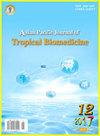Naringin attenuates oxidative stress, inflammation, apoptosis, and oxidative DNA damage in acrylamide-induced nephrotoxicity in rats
IF 1.7
4区 医学
Q3 TROPICAL MEDICINE
引用次数: 10
Abstract
Objective: To explore the possible effects of naringin on acrylamide-induced nephrotoxicity in rats. Methods: Sprague-Dawley rats weighing 200-250 g were randomly divided into five groups. The control group was given intragastric (i.g.) saline (1 mL) for 10 d. The acrylamide group was given i.g. acrylamide in saline (38.27 mg/kg titrated to 1 mL) for 10 d. The treatment groups were administered with naringin in saline (50 and 100 mg/kg, respectively) for 10 d and given i.g. acrylamide (38.27 mg/kg) 1 h after naringin injection. The naringin group was given i.g. naringin (100 mg/kg) alone for 10 d. On day 11, intracardiac blood samples were obtained from the rats when they were under anesthesia, after which they were euthanized. Urea and creatinine concentrations of blood serum samples were analyzed with an autoanalyzer. Enzyme-linked immunosorbent assay was used to quantify malondialdehyde, superoxide dismutase, glutathione, glutathione peroxidase, catalase, tumor necrosis factor-β, nuclear factor-κB, interleukin (IL)-33, IL-6, IL-1β, cyclooxygenase-2, kidney injury molecule-1, mitogen-activated protein kinase-1, and caspase-3 in kidney tissues. Renal tissues were also evaluated by histopathological and immunohistochemical examinations for 8-OHdG and Bcl-2. Results: Naringin attenuated acrylamide-induced nephrotoxicity by significantly decreasing serum urea and creatinine levels. Naringin increased superoxide dismutase, glutathione, glutathione peroxidase, and catalase activities and decreased malondialdehyde levels in kidney tissues. In addition, naringin reduced the levels of inflammatory and apoptotic parameters in kidney tissues. The histopathological assay showed that acrylamide caused histopathological changes and DNA damage, which were ameliorated by naringin. Conclusions: Naringin attenuated inflammation, apoptosis, oxidative stress, and oxidative DNA damage in acrylamide-induced nephrotoxicity in rats.柚皮苷减轻丙烯酰胺肾毒性大鼠氧化应激、炎症、细胞凋亡和DNA氧化损伤
目的:探讨柚皮苷对丙烯酰胺所致大鼠肾毒性的可能影响。方法:将体重200~250g的Sprague-Dawley大鼠随机分为5组。对照组灌胃(i.g.)生理盐水(1mL)10d。丙烯酰胺组灌胃丙烯酰胺盐水溶液(38.27mg/kg,滴定至1mL)10d。治疗组分别用柚皮苷盐水溶液(分别为50和100mg/kg)给药10d,并在柚皮苷注射后1h静脉给药丙烯酰胺(38.27g/kg)。柚皮苷组单独静脉注射柚皮苷(100mg/kg),持续10d。第11天,在大鼠处于麻醉状态时,从大鼠身上采集心内血样,然后对其实施安乐死。用自动分析仪分析血清样品的尿素和肌酸酐浓度。酶联免疫吸附法测定肾组织中丙二醛、超氧化物歧化酶、谷胱甘肽、谷胱甘肽过氧化物酶、过氧化氢酶、肿瘤坏死因子-β、核因子-κB、白细胞介素(IL)-33、IL-6、IL-1β、环氧合酶-2、肾损伤分子-1、丝裂原活化蛋白激酶-1和胱天蛋白酶-3的含量。肾组织还通过组织病理学和免疫组织化学检查评估8-OHdG和Bcl-2。结果:柚皮苷能显著降低血清尿素和肌酐水平,从而减轻丙烯酰胺引起的肾毒性。柚皮苷提高了肾组织中超氧化物歧化酶、谷胱甘肽、谷胱甘肽过氧化物酶和过氧化氢酶的活性,降低了丙二醛水平。此外,柚皮苷降低了肾组织中炎症和凋亡参数的水平。组织病理学分析表明,丙烯酰胺引起组织病理学改变和DNA损伤,柚皮苷可改善这种情况。结论:柚皮苷减轻丙烯酰胺肾毒性大鼠的炎症、细胞凋亡、氧化应激和DNA氧化损伤。
本文章由计算机程序翻译,如有差异,请以英文原文为准。
求助全文
约1分钟内获得全文
求助全文
来源期刊

Asian Pacific journal of tropical biomedicine
Biochemistry, Genetics and Molecular Biology-Biochemistry, Genetics and Molecular Biology (miscellaneous)
CiteScore
3.10
自引率
11.80%
发文量
2056
审稿时长
4 weeks
期刊介绍:
The journal will cover technical and clinical studies related to health, ethical and social issues in field of biology, bacteriology, biochemistry, biotechnology, cell biology, environmental biology, microbiology, medical microbiology, pharmacology, physiology, pathology, immunology, virology, toxicology, epidemiology, vaccinology, hematology, histopathology, cytology, genetics and tropical agriculture. Articles with clinical interest and implications will be given preference.
 求助内容:
求助内容: 应助结果提醒方式:
应助结果提醒方式:


